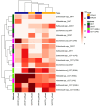Phenotypic Detection of Extended-Spectrum β-Lactamase and Carbapenemase-Producing Enterobacteriaceae from Wastewater Treatment Plants in Ouagadougou, Burkina Faso
- PMID: 40723944
- PMCID: PMC12291763
- DOI: 10.3390/antibiotics14070641
Phenotypic Detection of Extended-Spectrum β-Lactamase and Carbapenemase-Producing Enterobacteriaceae from Wastewater Treatment Plants in Ouagadougou, Burkina Faso
Abstract
Background/Objectives: The overuse of antibiotics has led to the emergence of antibiotic-resistant bacteria, posing a global public health challenge. Among these, extended-spectrum β-lactamase and carbapenemase-producing Enterobacteriaceae (ESBL-E and CPE) are of particular concern due to their potential to spread resistance in various environments. Understanding the prevalence and spread of these bacteria in the influent and effluent of wastewater treatment plants is essential. Methods: This study examined ESBL-E and CPE in wastewater from three WWTPs in Ouagadougou, Burkina Faso, and was conducted between February and August 2024. Phenotypic detection of ESBL-E was performed on the isolates using the double-disk synergy test and the combination disk test, whereas the CPE detection employed the combination disk test and the modified Hodge test. Results: A total of 250 Enterobacteriaceae isolates were found, with Escherichia coli, Klebsiella spp., Enterobacter spp., and Buttiauxella spp. the most predominant taxa. Phenotypic analysis revealed a high prevalence of ESBL-E, particularly in influent samples, with rates ranging from 55 to 98% across the WWTPs. CPE detection showed varying prevalence, with higher proportions identified in effluent samples, ranging from 37 to 68%, depending on the plant. These findings highlight the critical role of WWTPs in the persistence and potential spread of antibiotic-resistant bacteria. Conclusions: This study underscores the urgent need for improved wastewater treatment technologies and comprehensive monitoring systems to reduce the dissemination of ESBL-E and CPE in the environment. Addressing these challenges is crucial for mitigating the public health risks associated with antimicrobial resistance.
Keywords: Burkina Faso; CPE; ESBL-E; antibiotic-resistant bacteria; wastewater treatment plants.
Conflict of interest statement
The authors declare no conflicts of interest.
Figures
References
-
- Njeru J., Odero J., Chebore S., Ndung’u M., Tanui E., Wesangula E., Ndanyi R., Githii S., Gunturu R., Mwangi W., et al. Development, Roll-out and Implementation of an Antimicrobial Resistance Training Curriculum Harmonizes Delivery of in-Service Training to Healthcare Workers in Kenya. Front. Microbiol. 2023;14:1142622. doi: 10.3389/fmicb.2023.1142622. - DOI - PMC - PubMed
-
- Godman B., Egwuenu A., Wesangula E., Schellack N., Kalungia A.C., Tiroyakgosi C., Kgatlwane J., Mwita J.C., Patrick O., Niba L.L., et al. Tackling Antimicrobial Resistance across Sub-Saharan Africa: Current Challenges and Implications for the Future. Expert. Opin. Drug Saf. 2022;21:1089–1111. doi: 10.1080/14740338.2022.2106368. - DOI - PubMed
Grants and funding
LinkOut - more resources
Full Text Sources
Research Materials
Miscellaneous



